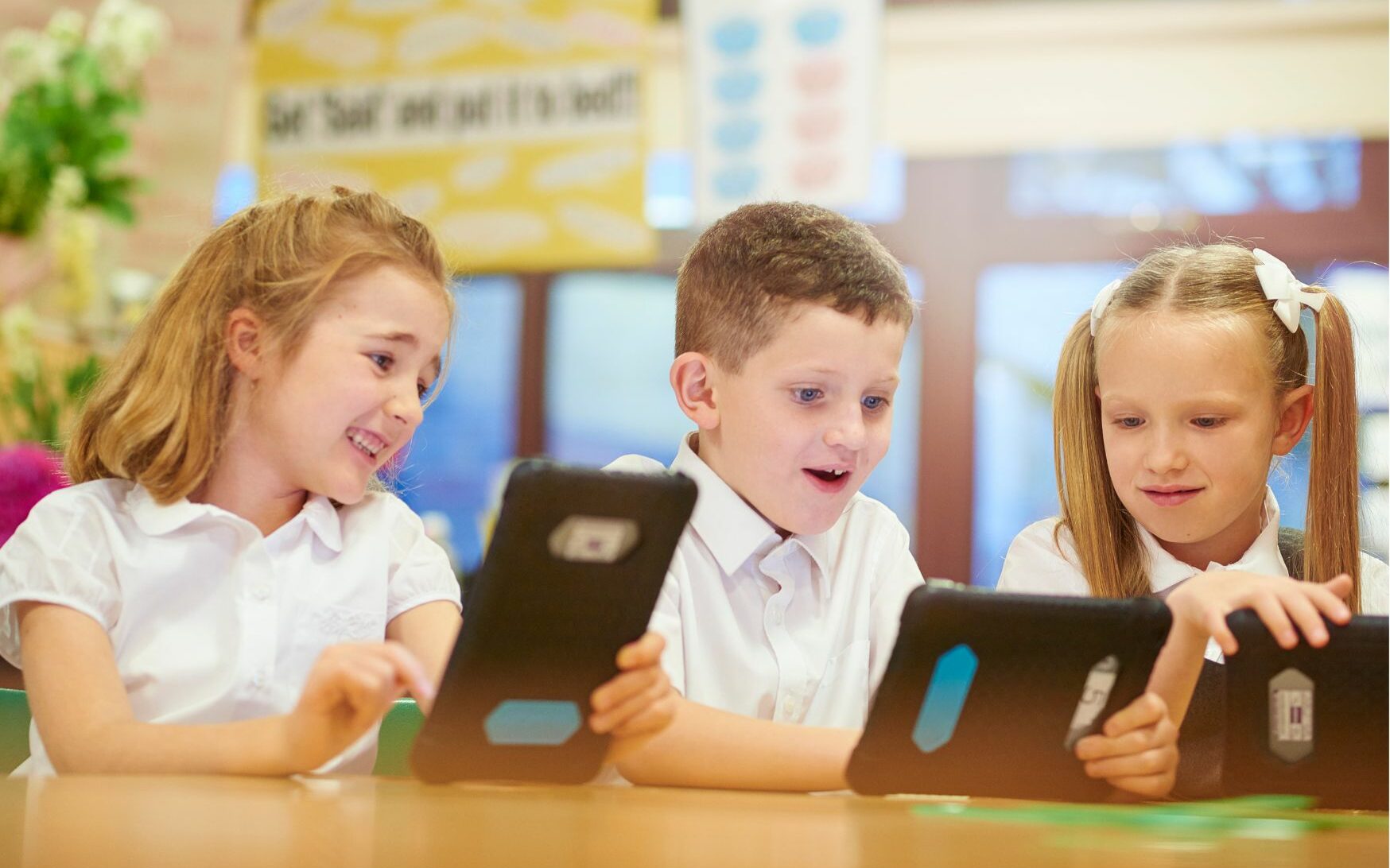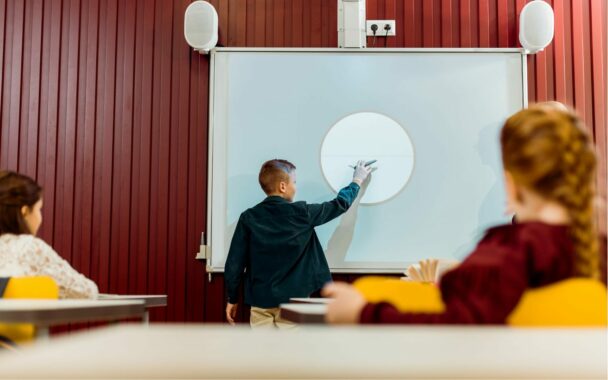Introduction to EdTech
‘EdTech’ short for Educational Technology, refers to the use of digital tools in a learning environment designed to enhance teacher-led learning in classrooms and improve students’ learning outcomes.
In recent years, there has been an evolution in educational technology, with more and more schools making this paperless shift. Progressively, teachers have digitally transformed their classrooms and embraced technology as an integral part of the education system.
The power of Educational Technology has transformed schools in many positive ways. New technology software, applications, and learning platforms support the ever-more-diverse learning styles of students. There is a multitude of EdTech options available for every student’s learning needs: visual learners, auditory learners, tactile learners, and kinaesthetic learners.
What are the benefits of integrating technology into education?
- Helps pupils become technologically skilled;
- Improves the administration and management of classrooms;
- Enhances communication amongst students, teachers, and parents;
- Provides instant feedback for teachers;
- Prepares students for the future;
- Improves student engagement;
- Encourages collaboration;
- Embraces a variety of learning styles;
- Technology secures a faster pace of learning.
What platforms, software, and tools should I use?
It isn’t easy keeping up with the ever-changing technological world around us, there are many choices on the market, of course, and it can be challenging to choose which resources, platforms, and programs are worth investing in for your classroom.
It is essential to use the best tools out there to engage and keep up with these tech-savvy students. You stand no chance of being named the ‘cool teacher’ if you aren’t up to date with the latest and best EdTech tools!
That is why we have created this easy toolbox of Digital Learning, Assessment, Management, and Collaboration platforms to tailor EdTech to your classroom needs.
1. Digital Learning Platforms

The future of education involves a combination of traditional and online teaching methods. Using the following e-learning tools, teachers can prepare presentations for a lesson, interact with students and caregivers, and create discussion forums using both text and video – all stored in the cloud for easy access and record-keeping. Plus, with open communication channels, human interaction is not lost. As students familiarize themselves with digital learning tools and online study tricks, they gain autonomy and learn important tech skills useful across subjects.
For presenting the curriculum:
- Sutori: a collaborative instruction and presentation tool for all ages;
- Insert Learning: a Chrome plugin that helps teachers transform every platform into an immersive online class;
- Additional tools: Tes Tech, Empatico.
For evaluation:
- PlayPostit: an interactive web-based video platform that enables educators to provide formative evaluation tasks;
- StudyBlue: an app that allows students to make and exchange flashcards;
- Quizlet: a simple learning tool that lets you study anything with flashcards, games, and other activities.
For independent learners:
- TED-Ed: a website offering a selected collection of educational video tutorials on a wide range of topics.
For project-based learners:
- PenPal Schools: connects students from 150 countries through project-based learning, students can create projects on a range of topics.
2. Digital Assessment Platforms
Digital evaluation, or e-assessment, refers to testing student achievement using technology. Examples include online essays, surveys, quizzes, or games. Correcting and grading assignments can be time-consuming on the part of the teacher, but thanks to new online platforms and the increased accessibility of mobile devices, educators can now evaluate students’ work more efficiently. Teachers can use digital evaluation tools to create survey-based assessments, gamify answers, and provide students with more immediate feedback.
The following online formative assessment tools provide opportunities for both self-and peer assessment, encouraging students to reflect on their own progress and motivation.
How can this be integrated into the classroom?
- Create online tests with audio, video, and animation;
- Digital feedback for everyone in a variety of forms; audio messages, skill scores, etc;
- Submitting assignments digitally through images and documents.
The best digital assessment platforms:
- Peergrade: a website to help students receive written input on their written work;
- Edpuzzle: A free assessment-centered tool that allows teachers and students to create interactive online videos and embed questions, audio notes, or comments in the form of a video;
- Kaizena: a Google Docs add-on for fast and high-quality feedback;
- Kiddom: a combination grade book to create formative tests and assignments;
- Additional tools: Sown to Grow, Plickers, Edulastic, Gradecam, Floop.
3. Interactive EdTech Tools

Interaction is at the core of learning. When teachers and students engage in dialogue – exchanging ideas with one another or analyzing information together – they are more likely to remember what they have learned and feel motivated to examine a subject more closely. Especially as more and more classrooms begin to incorporate some form of distance learning, consistent communication between teachers and students is essential to maintaining a positive, interactive learning environment.
The following Interactive Education tools allow users to communicate virtually, whether by creating and sharing digital content, or grouping students’ work into one project space for easy assessment. Many of these programs are also compatible with different devices, so users can sync and access information anywhere, anytime.
The best interactive tools:
- Microsoft Teams: a collaboration network where teams communicate through shared notebooks, chat sessions, virtual meetings, and sharing resources;
- Google Classroom: a learning management system that allows teachers to control workflow and communicate with their students;
- Blackboard: provide students with course records, online assignments, individual grades, and reviews;
- Additional tools: Buncee, Wizer, Genially.
4. Classroom Management Tools

Classroom and behavioral management can be a significant cause of stress for many teachers, but it doesn’t have to be that way. There are a variety of online tools available to help teachers establish a behavioral code and optimize learning in the classroom.
The following apps assist teachers in managing time, setting achievable goals and objectives for students, modeling appropriate behaviors, and promoting collective positive reinforcement in order to stimulate students’ motivation. With these digital tools, teachers can document students’ progress, connect with their caregivers, correct homework, communicate with students in virtual forums, control the noise level in the classroom, and more.
For classroom organization:
- ClassDojo: an online classroom management tool with which teachers can document student actions, encourage classroom activity, create original projects, and upload class updates;
- Class Charts: automated seating charts to stop those two chatter boxes’ from sitting together;
- Symbaloo: for a research organization, bookmarking websites, and arranging web links;
- LiveBinders: a digital binder you can take anywhere and everywhere.
For behavioral codes:
- Bouncy Balls: a simple, free loud sound meter to control class noise levels;
- Highfive: an app that helps educators create and infuse social-emotional learning, restorative activities, and trauma-informed interventions through behavioral monitoring options;
- ClassroomQ: a web-based interactive hand-raising platform for waiting in line to speak in a digital queue.
For increased class concentration:
- GoNoodle: a compilation of animations, games, and events that promote physical activity in class (perfect for kinaesthetic learners).
5. Project Management Systems

Project Management Systems are a means by which educators can plan and organize their work, set and monitor goals, motivate students with virtual tasks, and keep tabs on classroom resources. They allow teachers and students to consolidate materials across subjects, collaborate with one another, track learning progress, submit homework assignments, share relevant info virtually, and more.
The following Project Management Systems help teachers manage time, organize activities into a virtual agenda, or create interactive content to enhance lessons or assignments.
For time and progress tracking:
- Toggl Track: a time-tracking app that allows you to track daily activities across different platforms;
- Microsoft to-do: a highly functional to-do list application that’ll help anyone keep their personal projects and tasks on time and on target;
- Additional tools: Miro, Basecamp, Chalk Planboard, Trello.
For project communication and collaboration:
- Padlet: a website and tool that helps students communicate ideas on interactive bulletin boards;
- Slack: a channel-based messaging network for more efficient collaboration with colleagues and team members;
- Kami: an immersive classroom software designed to turn every single text into an engaging learning environment;
- Lucidchart: a proprietary web-based application that helps users collaborate on drawing, revision, and exchanging charts and diagrams.
For notetaking:
- Coggle: an online platform for creating and uploading mind maps;
- Evernote: a free app for your smartphone and computer that saves everything you might ever imagine;
- Notability: combine handwriting, photographs, and typing in a single message to bring your projects to life;
- Additional tools: Rocketbook, Google Keep, Edji.
Conlcusions
In summary, all these listed applications, software, and platforms embrace a variety of learning styles that exist within a classroom and the use of these digital tools will undoubtedly prove to be beneficial in communication, management, collaboration, learning, and assessment. After having discussed these integral aspects of EdTech in the classroom and discovered the multitude of resources available, it is now time for you to explore which of these platforms you will add to your personal toolbox to improve engagement and facilitate the transition into digital teaching and learning.
If you are interested in learning more about digital learning, check out our available courses:

